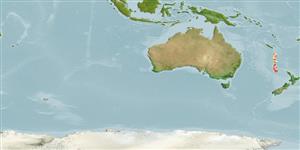Ελασμοβράγχιοι (καρχαρίες και σαλάχια) (sharks and rays) >
Rajiformes (Skates and rays) >
Arhynchobatidae (Softnose skates)
Etymology: Notoraja: Greek, noton = back + Latin, raja = fish, Raja sp. (Ref. 45335); sapphira: From the Greek sappheiros in reference to its intense blue dorsal coloration resembling that
of a dark sapphire (gemstone).
More on authors: Séret & Last.
Environment: milieu / climate zone / depth range / distribution range
Οικολογία
Θαλασσινό(ά) βενθοπελαγικό; εύρος βάθους 1195 - 1313 m (Ref. 81757). Subtropical; 25°S - 35°S, 167°E - 169°E (Ref. 114953)
West Pacific: Coral Sea and Tasman Sea. Known only from the five type specimens collected on the slopes of the Norfolk Ridge. Also from New Caledonia (Ref. 86942, Ref. 114953).
Μέγεθος / Βάρος / Age
Maturity: Lm ? range ? - ? cm
Max length : 36.0 cm TL αρσενικό/απροσδιόριστο; (Ref. 81757); 41.3 cm TL (female)
Short description
Κλείδες προσδιορισμού | Μορφολογία | Μορφομετρία
This medium-size (413 mm TL) species is distinguished by the following set of characters: heart-shaped disc with a short projected snout tip; disc slightly wider than long, its width 51-54% of TL, and length 47-48% TL; short snout, its preorbital snout length 12-15% TL, preoral snout length 12-15% TL; interorbital width 3.6-4.1% TL; interspiracular width 6.0-6.6% TL; long and slender tail, its length from posterior margin of cloaca to tip of tail 54-58% TL; dorsal surface of disc largely free of dermal denticles; rostrum with some denticles, without thorns; a small but distinct preorbital thorn on anterior upper orbital rim; denticles present on posterior mid-dorsal trunk; tail prickly with dense, irregular and randomly arranged thorns; mid-dorsal row on tail hardly distinct from the rest of thorn pattern; naked ventral surface of disc and tail; upper jaw with 29-36 tooth rows, lower with 28-32; pectoral-fin radials 67-70; monospondylous trunk centra 23-25; predorsal caudal diplospondylous centra 70-74; total number of centra 126-134; dorsal surface rich blue, uniform, with a narrow blackish outer margin; ventral surface of disc and tail brownish black, gill slits darker, cloaca opening and mouth corners whitish (Ref. 81757).
Life cycle and mating behavior
Γεννητική Ωρίμανση | Αναπαραγωγή | Γεννοβολία | Αβγά | Γονιμότητα | Προνύμφες
Séret, B. and P.R. Last, 2009. Notoraja sapphira sp. nov. (Rajoidei: Arhynchobatidae), a new deepwater skate from the slopes of the Norfolk Ridge (South-West Pacific). Zootaxa 2153:24-34. (Ref. 81757)
IUCN Red List Status (Ref. 130435: Version 2024-1)
Threat to humans
Harmless
Human uses
αλιεία: χωρίς ενδιαφέρον
Εργαλεία
Special reports
Download XML
Διαδικτυακές πηγές
Estimates based on models
Phylogenetic diversity index (Ref.
82804): PD
50 = 0.5001 [Uniqueness, from 0.5 = low to 2.0 = high].
Bayesian length-weight: a=0.00562 (0.00288 - 0.01097), b=3.11 (2.94 - 3.28), in cm total length, based on LWR estimates for this (Sub)family-body shape (Ref.
93245).
Τροφικό Επίπεδο (Ref.
69278): 3.7 ±0.7 se; based on size and trophs of closest relatives
Ελαστικότητα (Ref.
120179): Χαμηλό, ελάχιστος χρόνος για διπλασιασμό πληθυσμού 4,5 - 14 έτη (Preliminary low fecundity).
Fishing Vulnerability (Ref.
59153): Low to moderate vulnerability (31 of 100).
